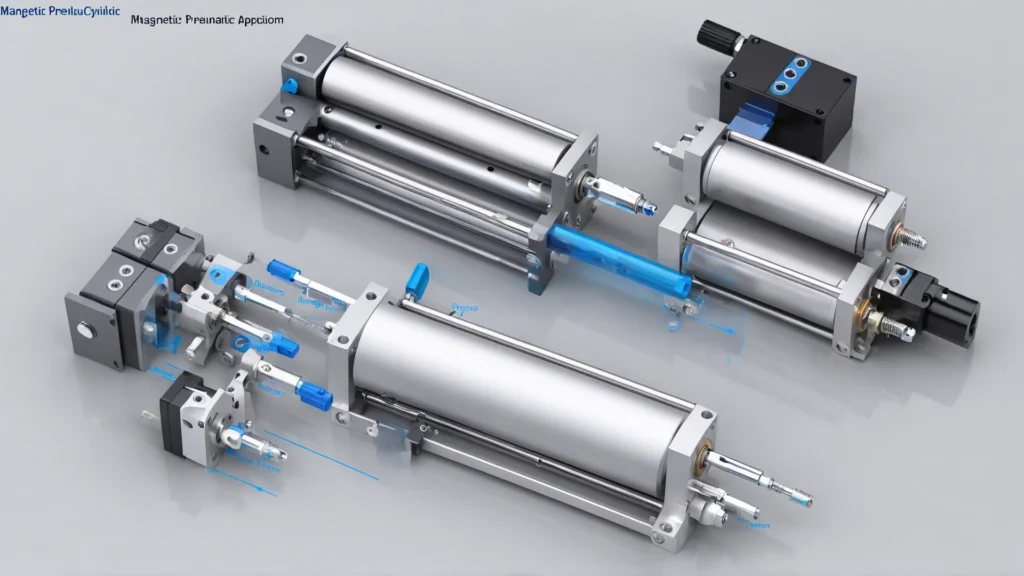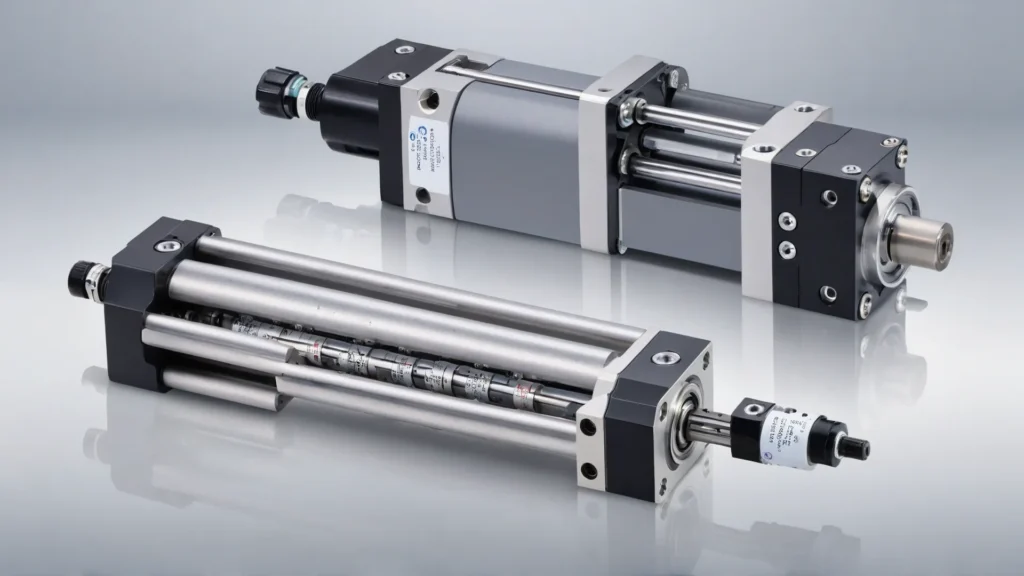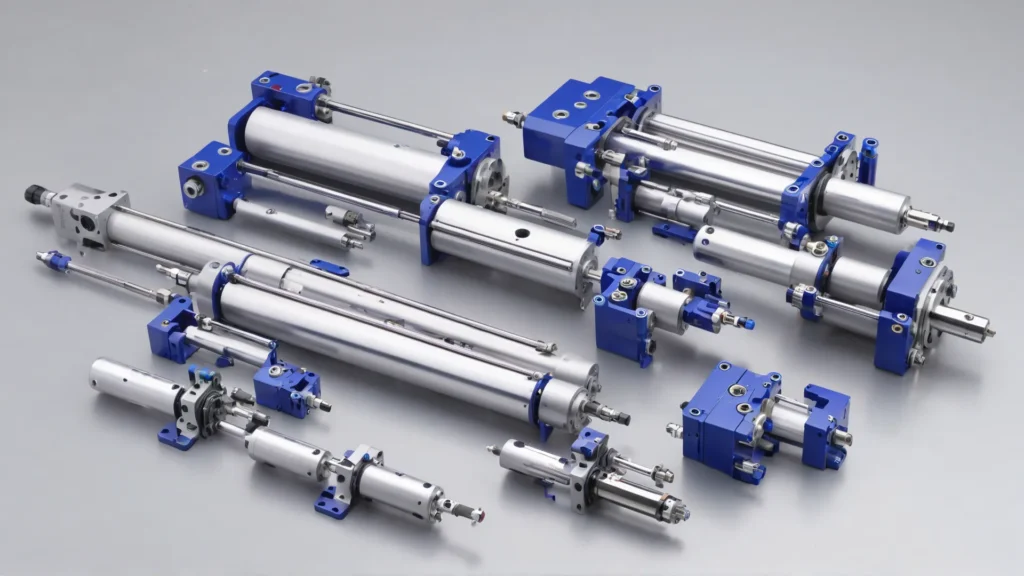What Is Magnetic Pneumatic Cylinder
Have you ever wondered what a magnetic pneumatic cylinder is?
In simple terms, it’s a type of pneumatic cylinder that uses magnetic force to control the movement of the piston rod. This unique design offers several advantages over traditional pneumatic cylinders.
In this blog post, we’ll dive deeper into the workings of magnetic pneumatic cylinders.
What Is Magnetic Pneumatic Cylinder
A magnetic pneumatic cylinder is a type of pneumatic actuator that incorporates a built-in magnet for position sensing. This magnet allows for non-contact detection of the piston’s position within the cylinder, enabling precise control and monitoring of the cylinder’s movement.
The magnetic field generated by the magnet is detected by an external sensor, which can be connected to a control system. This setup offers advantages such as increased reliability, improved safety, and reduced maintenance requirements compared to traditional pneumatic cylinders with mechanical switches or sensors.
Components of Magnetic Pneumatic Cylinder
The main components of a magnetic pneumatic cylinder include:
- Cylinder body: Houses the piston and provides a sealed chamber for compressed air.
- Piston: Moves back and forth within the cylinder body, driven by compressed air.
- Piston rod: Attached to the piston, extending out of the cylinder to transmit motion.
- Magnet: Embedded in the piston, creating a magnetic field for position sensing.
- Sensor: Detects the magnetic field, providing feedback on the piston’s position.
- End caps: Seal the cylinder ends and provide ports for air input and exhaust.
- Seals: Prevent air leakage and ensure efficient operation of the cylinder.
How Does Magnetic Pneumatic Cylinder Work
A magnetic pneumatic cylinder combines the power of compressed air with the precision of magnetic sensors to control its movement. When compressed air is supplied to the cylinder, it forces the piston to move, which in turn moves the attached load.
The magnetic sensors, typically located on the cylinder body, detect the position of the piston as it moves. This allows for accurate control and monitoring of the cylinder’s position, speed, and force.
The magnetic sensors send signals to the control system, which can then adjust the air pressure or valve positions to precisely control the cylinder’s movement.

Types of Magnetic Pneumatic Cylinders
Cable Cylinders
Cable cylinders are a type of magnetic pneumatic cylinder that utilize a cable to transmit the magnetic field. This design allows for a more flexible and adaptable installation, as the cylinder can be positioned at a distance from the magnetic sensor.
Slotted Cylinders
Slotted cylinders feature a slot along the cylinder body, which allows the magnetic field to be detected by the sensor. This type of magnetic pneumatic cylinder provides a compact and reliable solution for position sensing in pneumatic systems.
Advantages of Magnetic Pneumatic Cylinders
- Enhanced Precision: Magnetic pneumatic cylinders offer superior precision in positioning and movement control. Integrated magnetic sensors enable accurate and repeatable positioning, ideal for high-precision applications.
- Increased Reliability: The non-contact design of magnetic sensors eliminates mechanical switches, reducing wear and tear. This results in increased reliability, extended service life, and minimized downtime and maintenance costs.
- Compact and Lightweight: Designed to be compact and lightweight, these cylinders are suitable for applications with limited space or weight constraints. The streamlined design allows easy integration into various machinery and equipment.
- Improved Safety: The absence of mechanical switches eliminates the risk of switch failure or malfunction. This enhances overall system safety, reducing potential accidents or unintended movements.
- Versatile Sensing Options: Magnetic pneumatic cylinders offer multiple sensing options, including various positions and analog output signals. This versatility allows for precise control and monitoring of cylinder position, enabling advanced automation and process control.
The Difference Between Magnetic and Non-Magnetic Pneumatic Cylinder
Detection of Piston Position:
Magnetic pneumatic cylinders: Magnetic pneumatic cylinders incorporate a built-in magnet that enables the detection of the piston’s position without the need for additional sensors. This feature simplifies the cylinder’s design and reduces the number of components required for operation.
Non-magnetic pneumatic cylinders: Non-magnetic pneumatic cylinders do not have an integrated magnet, necessitating the use of external sensors to determine the piston’s position accurately. While this may offer more flexibility in sensor placement, it also increases the complexity of the system and requires additional wiring and maintenance.
Space and Efficiency:
Magnetic pneumatic cylinders: Magnetic pneumatic cylinders are particularly advantageous in applications where space is limited, as they eliminate the need for bulky external sensors, making them a compact and efficient choice for many industrial automation tasks.
FAQs
In what applications are magnetic pneumatic cylinders commonly used?
Magnetic pneumatic cylinders are used in automation, robotics, manufacturing, and other applications requiring precise position control and reliable operation.
How accurate is the position sensing in a magnetic pneumatic cylinder?
The accuracy of position sensing depends on the specific design but can typically achieve a resolution of 0.1 mm or better.
Are magnetic pneumatic cylinders more expensive than standard pneumatic cylinders?
Yes, magnetic pneumatic cylinders are generally more expensive due to the added cost of the integrated position sensing technology.
Can magnetic pneumatic cylinders be used in environments with strong magnetic fields?
Yes, most magnetic pneumatic cylinders are designed to operate reliably in the presence of external magnetic fields.
What is the typical operating pressure range for magnetic pneumatic cylinders?
The operating pressure range varies by model but typically falls between 1 to 10 bar (14.5 to 145 psi).
How long do magnetic pneumatic cylinders typically last?
With proper maintenance, magnetic pneumatic cylinders can last for millions of cycles, depending on the application and operating conditions.
Are there any special maintenance requirements for magnetic pneumatic cylinders?
Maintenance requirements are similar to standard pneumatic cylinders, including regular inspection, lubrication, and replacement of worn components as needed.
In Conclusion
In conclusion, magnetic pneumatic cylinders offer a reliable and efficient solution for various industrial applications. Their unique combination of pneumatic power and magnetic sensing technology ensures precise and consistent performance.
To learn more about how magnetic pneumatic cylinders can benefit your specific application, contact a trusted supplier today.



